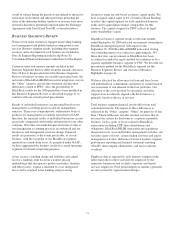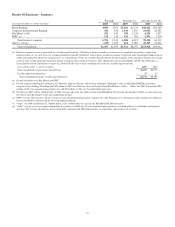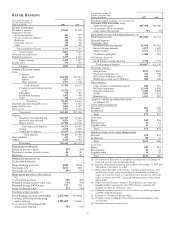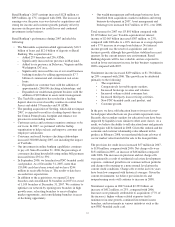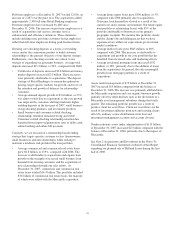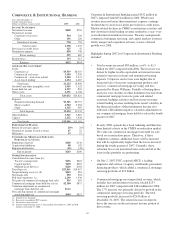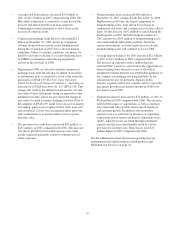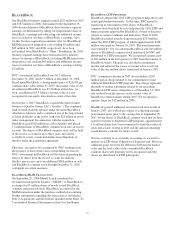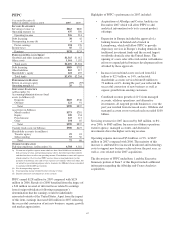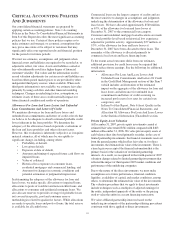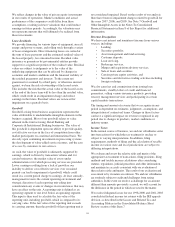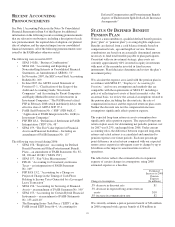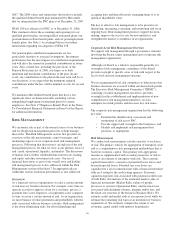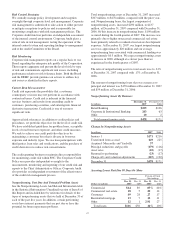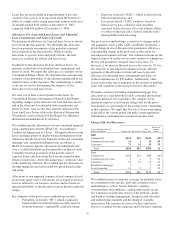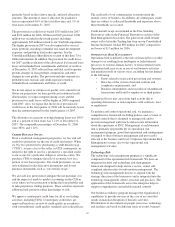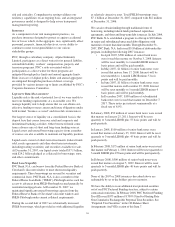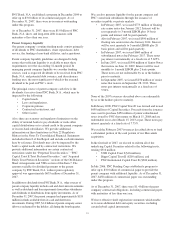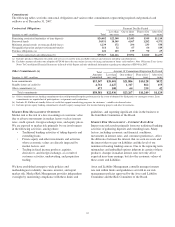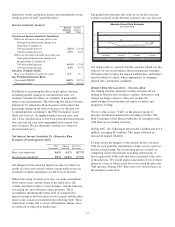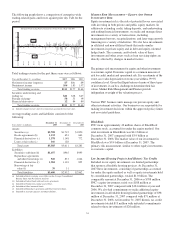PNC Bank 2007 Annual Report Download - page 49
Download and view the complete annual report
Please find page 49 of the 2007 PNC Bank annual report below. You can navigate through the pages in the report by either clicking on the pages listed below, or by using the keyword search tool below to find specific information within the annual report.We reflect changes in the value of private equity investments
in our results of operations. Market conditions and actual
performance of the companies could differ from these
assumptions, resulting in lower valuations that could reduce
earnings in future periods. Accordingly, the valuations may
not represent amounts that will ultimately be realized from
these investments.
Lease Residuals
We provide financing for various types of equipment, aircraft,
energy and power systems, and rolling stock through a variety
of lease arrangements. Direct financing leases are carried at
the sum of lease payments and the estimated residual value of
the leased property, less unearned income. Residual value
insurance or guarantees by governmental entities provide
support for a significant portion of the residual value. Residual
values are subject to judgments as to the value of the
underlying equipment that can be affected by changes in
economic and market conditions and the financial viability of
the residual guarantors and insurers. To the extent not
guaranteed or assumed by a third party, or otherwise insured
against, we bear the risk of ownership of the leased assets.
This includes the risk that the actual value of the leased assets
at the end of the lease term will be less than the residual value,
which could result in an impairment charge and reduce
earnings in the future. Residual values are reviewed for
impairment on a quarterly basis.
Goodwill
Goodwill arising from business acquisitions represents the
value attributable to unidentifiable intangible elements in the
business acquired. Most of our goodwill relates to value
inherent in the fund servicing, Retail Banking and
Corporate & Institutional Banking businesses. The value of
this goodwill is dependent upon our ability to provide quality,
cost effective services in the face of competition from other
market participants on a national and international basis. We
also rely upon continuing investments in processing systems,
the development of value-added service features, and the ease
of access by customers to our services.
As such, the value of goodwill is ultimately supported by
earnings, which is driven by transaction volume and, for
certain businesses, the market value of assets under
administration or for which processing services are provided.
Lower earnings resulting from a lack of growth or our
inability to deliver cost-effective services over sustained
periods can lead to impairment of goodwill, which could
result in a current period charge to earnings. At least annually,
management reviews the current operating environment and
strategic direction of each reporting unit taking into
consideration any events or changes in circumstances that may
have an effect on the unit. A reporting unit is defined as an
operating segment or one level below an operating segment.
This input is then used to calculate the fair value of the
reporting unit, including goodwill, which is compared to its
carrying value. If the fair value of the reporting unit exceeds
its carrying amount, then the goodwill of that reporting unit is
not considered impaired. Based on the results of our analysis,
there have been no impairment charges related to goodwill for
the years 2007, 2006, and 2005. See Note 7 Goodwill and
Other Intangible Assets in the Notes To Consolidated
Financial Statements in Item 8 of this Report for additional
information.
Revenue Recognition
We derive net interest and noninterest income from various
sources, including:
• Lending,
• Securities portfolio,
• Asset management and fund servicing,
• Customer deposits,
• Loan servicing,
• Brokerage services,
• Merger and acquisition advisory services,
• Sale of loans and securities,
• Certain private equity activities, and
• Securities and derivatives trading activities including
foreign exchange.
We also earn fees and commissions from issuing loan
commitments, standby letters of credit and financial
guarantees, selling various insurance products, providing
treasury management services and participating in certain
capital markets transactions.
The timing and amount of revenue that we recognize in any
period is dependent on estimates, judgments, assumptions, and
interpretation of contractual terms. Changes in these factors
can have a significant impact on revenue recognized in any
period due to changes in products, market conditions or
industry norms.
Income Taxes
In the normal course of business, we and our subsidiaries enter
into transactions for which the tax treatment is unclear or
subject to varying interpretations. In addition, filing
requirements, methods of filing and the calculation of taxable
income in various state and local jurisdictions are subject to
differing interpretations.
We evaluate and assess the relative risks and merits of the
appropriate tax treatment of transactions, filing positions, filing
methods and taxable income calculations after considering
statutes, regulations, judicial precedent, and other information,
and maintain tax accruals consistent with our evaluation of
these relative risks and merits. The result of our evaluation and
assessment is by its nature an estimate. We and our subsidiaries
are routinely subject to audit and challenges from taxing
authorities. In the event we resolve a challenge for an amount
different than amounts previously accrued, we will account for
the difference in the period in which we resolve the matter.
We resolved disputed issues for our 1998-2000 and 2001-2003
consolidated federal income tax returns with the IRS appeals
division, as described in the Leases and Related Tax and
Accounting Matters in the Consolidated Balance Sheet
Review section of this Item 7.
44


